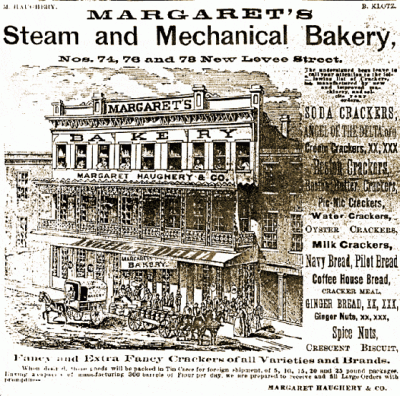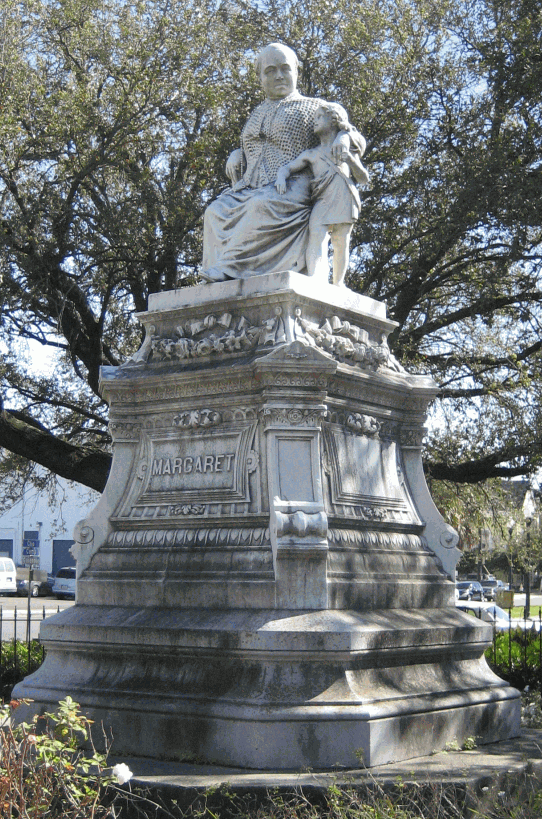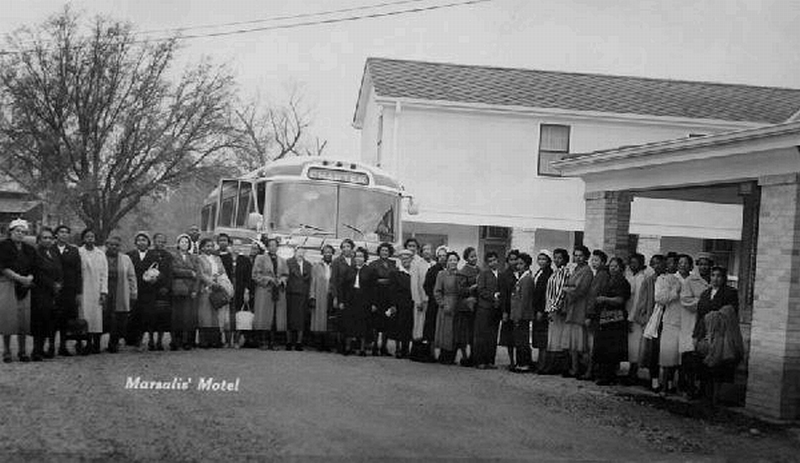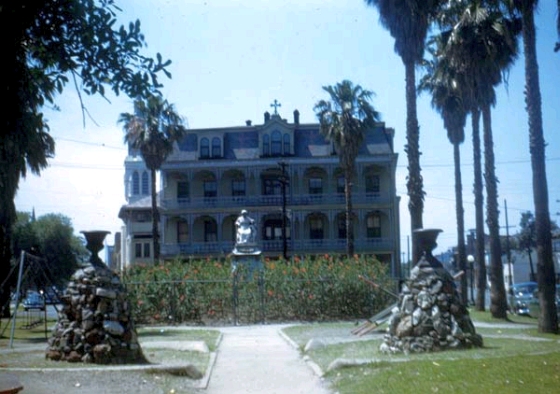
1404 Clio Street
April 16, 1950
The photo above, from the
New Orleans Public Library's Dorothy Violet Gulledg Collection, of the old structure on Clio Street, near Lee Circle, was
taken on April 16, 1950. The building still stands, as does the monument to Margaret Haughery.
On November 20, 1835 a young Irish-born woman, her husband, and young daughter arrived
in New Orleans on the ship Hyperion. They had left their home in Baltimore because they were advised that his health
might improve in the southern climate. He died shortly thereafter and, within months of his death, the beloved baby
girl also died. Margaret Haughery was a 23 year-old illiterate, uneducated, penniless, childless widow in a city she
barely knew. Her life had been touched by great loss before. At the age of nine her parents died. She is often
quoted as saying, after losing her baby, 'My God! Thou hast broken every tie. Thou hast stripped me of all. Again I am all
alone'
She began working in the laundry of the St. Charles Hotel
and was touched by the plight of orphan children she could see on the streets through the window while she ironed all day,
everyday. She vowed to help the Sisters of Charity in their efforts to care them. She not only applied her meager
savings and sparse spare-time to the care of the children, but also collected clothing and furniture and begged for food and
cash donations from nearby businesses and restaurants. In 1836 Margaret moved in with the nuns at Poydras Asylum and
purchased and cared for two cows who provided milk for the children. She went into the streets, with a cart, to
sell and deliver any milk not needed by the children. Her industriousness and hard work resulted in a successful commercial
dairy which eventually consisted of about 40 cows. In 1841, she moved with the nuns to open the New Orleans Female Asylum
on New Levee Street, now Convention Center Boulevard. (Photo on the left -- circa 1842 Portrait of Margaret with Two
Orphans by Jaques Amans, New Orleans)

In 1880, Margaret acquired a bakery at 70 through 78 New Levee Street which grew into one of the largest in the city.
As before, the first products went to the orphans, the rest was sold. Working in partnership with the Sisters of Charity,
Margaret fed not only orphans but the city's needy adults. She generously supported St. Theresa's Asylum, St. Elizabeth's
Asylum, St. Vincent's Infant Asylum and other similar institutions. It has been estimated that, while living, she donated
an estimated $600,000 to charitable endeavors. In addition, she personally cared for yellow fever victims, widows, homeless
men, pregnant teenagers, Confederate Veterans, and anyone who sought her help.
Upon her death, on February 9, 1882, she bequeathed most of her $50,000 estate to the poor of New Orleans.
Participants in her funeral ceremonies included Archbishop Napoléon-Joseph Perché, 13 priests, Mayor Benjamin
Flanders, and Lieutenant Governors George L. Walton and W.A. Robertson. Thousands of people, including prominent politicians,
businessmen, and members of the clergy attended her funeral. As did the orphans and their caregivers. The people of
New Orleans lined the streets to mourn the passing of her remains to St. Patrick's Church and St. Louis Cemetery No. 2 (her
remains were later relocated to St. Louis No. 3).

She became known, during her lifetime, as “The Bread Woman of New Orleans". A century and a quarter later,
we know her as simply "Margaret" and are reminded of her life devoted to children by the statue at Margaret Park
in front of the old orphanage. The story of the statue attests to how beloved she was by so many. Almost immediately after
her death an executive committee was formed and headed by George Horter to raise funds for a memorial. Rich and poor
contributed and the $6000 needed to make it a reality was soon collected. Alexander Doyle, who was working on the Robert
E. Lee statue for Lee Circle, was commissioned to design Margaret's statue. His model was sent to Italy, where the monument
was carved in fine Carrara marble. In keeping with Margaret's frugal personal lifestyle, Doyle portrayed her sitting in her
favorite plain wooden chair, clothed in a simple dress and shawl. Her left arm is draped lovingly around a young boy
whose face reflects his love for her. Those who knew her, were astounded by its likeness.
The statue was shipped from Carrara, Italy on April 24, 1884. In May, the city pondered its fate as
the ship Castalla, which was thought to have transported it, ran aground off the coast and was forced to throw over part of
its cargo to become afloat again. The statue was more likely transported on the steamer Italia, from Livorno on May
6 of that year. Two sections of the seven-foor pedestal had already arrived in New Orleans.
The monument was placed on a triangular plot of land (adjacent to the Louise Home for girls) which had been
a dumping ground but was cleaned up and planted with flowers and grass. The small park is surrounded by Calliope, Camp,
Erato and Pryatania streets and is named for her -- Margaret Place. At its dedication, on July 9, 1884, children from
every orphanage attended, Governor Francis T. Nicholls was the principal speaker, and notables and humble people from throughout
town gathered, as did Mayor J. Valsin Guillotte and members of the city council.
The statue is often said to be the first dedicated in the memory of a woman built in the United States.
It is, in fact the first built by popular subscription. A public monument (built with tax dollars ) honoring Hannah Duston,
who fought an Indian attack in 1697 was erected in Haverhill, Massachusetts in 1861. A second monument to Duston was
erected in 1874 on the island in Boscawen, New Hampshire where she killed. But Margaret's statue remains the first
known to have been erected in honor of a beloved woman, funded freely out of the pockets of those who returned their love
for her.
Thirteen years after her death, on October 8, 1895,
Margaret's memory was still dear to New Orleanians -- a fireworks show titled "Last Days of Pompeii" was held at
Athletic Park (Canal at St. Patrick streets) which included "a fine portrait of the Margaret Statue in lines of colored
fire" -- 30 feet by 25 feet in size. Eighteen years after her death, from May 24 to May 26, an orphan fund raiser offered
a prize for the best recreation of the Margaret Statue created with flowers and flags.
In August 1912 vandals broke the index finger from the right hand of the statue, creating public outrage.
But it was not until June 1925 that the Committee of Public Property, headed by John Klorer, authorized stonecutter W. E.
Martel to repair the damage. That same year the Margaret Park Commission had requested the repair and were planning to beautify
the park, again. When Albert Sidney Conner, the boy who had posed for the statue as a three-year old, died on November
30, 1913 at the age of 31, the news of his passing was noted.
In
1936 the statue was cleaned after a campaign was held to raise funds. During the late 1960s a public school was named for
Margaret. It served pregnant teenagers who were not allowed to attend their home schools. When the Pontchartrain Expressway
was built, an on-ramp hid Margaret Place from much public view. From the early 1960s through the mid 1970s, Margaret
Day was observed at the park on the anniversary of her death. By the mid 70s, the neighborhood had fallen into deep
disrepair and the statue was surrounded by a tall fence topped with barbed wire. In 1988 the Margaret Place Restoration
Project, in partnership with the Parkway and Parks Commission raised funds for its restoration. In the 1990s, following
removal of the Camp Street expressway ramp, the Parkway Partners along with the Coliseum Square Association refurbished
the statue.
Other cities can claim women recognized immediately
by their first names only -- there's Liza (with a Z), Cher (without Sonny), Madonna, and many more. We have Margaret,
the kind lady who overcame heartbreak to devote her life to uplifting the lives of men, women, teenagers, and children.
Through the years she has been known as the “Mother of Orphans,” "Saint Margaret", “The
Bread Woman of New Orleans", and “Our Margaret”. It speaks well of us that we remember her, still,
so many years after her passing. (Photo by
Infrogmation)
You Can Support this Site by Clicking on & Shopping from this Amazon Link -- and it
won't cost you a penny more:


On April 16, 1981, Reynard Rochon announced the appointment of Henry Morris as Superintendent
of Police and Warren Woodfork as Deputy Superintendent.
Acclaimed author Mary Alice Fontenot was born on April 17, 1910. She wrote
the "Clovis Crawfish" series, in which the title character and his animal friends experienced
a host of adventures. The goal of the series, for which she penned 18 different books, was to
teach life lessons to children while helping them learn a little of the Cajun French language;
Clovis and his pals spoke mostly English with Cajun sayings and songs thrown in. She also wrote other books,
including "The Star Seed" and "The Louisiana Experience." Ms. Fontenot passed away on
May 12, 2003.
Early in the American Civil War New Orleans was captured by the Union without a battle in the city
itself, and hence was spared the destruction suffered by many other cities of the American South. It retains a historical
flavor with a wealth of 19th century structures far beyond the early colonial city boundaries of the French Quarter. The
political and commercial importance of New Orleans, as well as its strategic position, marked it out as the objective of a
Union expedition soon after the opening of the Civil War. Elements of the Union Blockade fleet arrived at the mouth of the
Mississippi on 27 May 1861. An effort to drive them off lead to the Battle of the Head of Passes on 12 October 1861. Captain
D.G. Farragut and the Western Gulf squadron sailed for New Orleans in January 1862. The main defenses of the Mississippi
consisted of the two permanent forts, Fort Jackson and Fort St. Philip. On April 16, 1862, after
elaborate reconnaissances, the Union fleet steamed up into position below the forts and opened fire two days later. Within
days, the fleet had bypassed the forts in what was known as the Battle of Forts Jackson and St. Philip. At noon on the 25th,
Farragut anchored in front of New Orleans. Forts Jackson and St. Philip, isolated and continuously bombarded by Farragut's
mortar boats, surrendered on the 28th, and soon afterwards the military portion of the expedition occupied the city resulting
in the Capture of New Orleans.
Photo of 1002 Esplanade Avenue--erected by New Orleans Building & Improvement Co. on
April 16, 1834; sold in 1838 to Jean Baptiste
Dupiere; when sold to Joseph Dusuau it was a two-story mansion; third added later. (NOPL)
Ellis Louis Marsalis Sr. is Born
April 16, 1908

In 1943 Ellis Louis Marsalis Sr., born on April 16, 1908, converted
a chicken barn at 110 Shrewsbury Road at the river (across the street from what is now The Rivershack) into the 40-room
Marsalis' Motel complete with a swimming pool, restaurant, and lounge. Also known as Marsalis Mansion, and Marsalis
Tourist Home, from 1943 to 1986 it was one of the only motels open to African Americans traveling to New Orleans.
Reverend Martin Luther King Jr., Congressman Adam Clayton Powell Jr., future Supreme Court Justice Thurgood Marshall,
Ray Charles, and other prominent civil rights activists, politicians, and musicians stayed there along with thousands
of lesser known Black travelers. Marsalis was, himself, active in promoting equal rights in his community and
served as president of the Nationwide Hotel Association.
In 1933, he married Florence Robertson, whom he had
met while enrolled in night school. They had two children, .Yvette Washington and Ellis Jr. In 1936, Ellis
Sr. and William Wicker's Esso gas station at Eighth Street and Howard Avenue was the first African American-owned station
in the area. While managing the hotel he promoted positive change in the community by organizing the Boosters Club,
which registered African American voters throughout New Orleans. He was an active member of the local Republican
Party who was elected in 1967 (the year he also expanded the motel and added The Broaster House restaurant to it) to serve
on the Republican Executive Committee and served as its treasurer. He was a delegate to The Republican Presidential
Convention of 1964. .In 1969 he was a a member of the Advisory Committee of the Social Welfare Planning Council.
He assisted David Treen's successful 1982 campaign for Louisiana Governor. . He helped finance the education of Ernest Nathan
Morial ("Dutch"), the first Black student to attend the Louisiana State University Law School, and who became
the first Black mayor of New Orleans. Marsalis also played a role in the election of Judge Lionel Collins, the first Black
Judge of the 24th Judicial District Court, in Gretna, Louisiana.
His daughter Yvette Marsalis Washington helped
him run the motel after her mother's death in 1973. Ellis Jr. become an excellent jazz pianist and music professor
who mentored gifted young New Orleans musicians including Harry Connick Jr.. His grandsons trumpeter Wynton, saxophonist
Branford, trombonist Delfeayo, and drummer Jason are renowned musicians.
The achievements earned by Ellis Marsalis
and like-minded civil rights activists led to the demise of the hotel -- which was no longer needed as a haven for black
travellers. Marsalis's Mansion Motel closed on September 25, 1986, demolished in July 1993, and its property
sold in July 2006. It remains an empty lot across the street from The Rivershack.
Active in St. James A.M.E.
Church, the Dryades Street Y.M.C.A., a 32nd-degree member of the Ancient and Accepted Scottish Rite of Freemasonry,
and patriarch to one of New Orleans' most celebrated musical families Mr. Marsalis passed away at the Ochsner Foundation
Hospital on September 19, 2004 at the age of 96.








 In 1880, Margaret acquired a bakery at 70 through 78 New Levee Street which grew into one of the largest in the city.
As before, the first products went to the orphans, the rest was sold. Working in partnership with the Sisters of Charity,
Margaret fed not only orphans but the city's needy adults. She generously supported St. Theresa's Asylum, St. Elizabeth's
Asylum, St. Vincent's Infant Asylum and other similar institutions. It has been estimated that, while living, she donated
an estimated $600,000 to charitable endeavors. In addition, she personally cared for yellow fever victims, widows, homeless
men, pregnant teenagers, Confederate Veterans, and anyone who sought her help.
In 1880, Margaret acquired a bakery at 70 through 78 New Levee Street which grew into one of the largest in the city.
As before, the first products went to the orphans, the rest was sold. Working in partnership with the Sisters of Charity,
Margaret fed not only orphans but the city's needy adults. She generously supported St. Theresa's Asylum, St. Elizabeth's
Asylum, St. Vincent's Infant Asylum and other similar institutions. It has been estimated that, while living, she donated
an estimated $600,000 to charitable endeavors. In addition, she personally cared for yellow fever victims, widows, homeless
men, pregnant teenagers, Confederate Veterans, and anyone who sought her help.  She became known, during her lifetime, as “The Bread Woman of New Orleans". A century and a quarter later,
we know her as simply "Margaret" and are reminded of her life devoted to children by the statue at Margaret Park
in front of the old orphanage. The story of the statue attests to how beloved she was by so many. Almost immediately after
her death an executive committee was formed and headed by George Horter to raise funds for a memorial. Rich and poor
contributed and the $6000 needed to make it a reality was soon collected. Alexander Doyle, who was working on the Robert
E. Lee statue for Lee Circle, was commissioned to design Margaret's statue. His model was sent to Italy, where the monument
was carved in fine Carrara marble. In keeping with Margaret's frugal personal lifestyle, Doyle portrayed her sitting in her
favorite plain wooden chair, clothed in a simple dress and shawl. Her left arm is draped lovingly around a young boy
whose face reflects his love for her. Those who knew her, were astounded by its likeness.
She became known, during her lifetime, as “The Bread Woman of New Orleans". A century and a quarter later,
we know her as simply "Margaret" and are reminded of her life devoted to children by the statue at Margaret Park
in front of the old orphanage. The story of the statue attests to how beloved she was by so many. Almost immediately after
her death an executive committee was formed and headed by George Horter to raise funds for a memorial. Rich and poor
contributed and the $6000 needed to make it a reality was soon collected. Alexander Doyle, who was working on the Robert
E. Lee statue for Lee Circle, was commissioned to design Margaret's statue. His model was sent to Italy, where the monument
was carved in fine Carrara marble. In keeping with Margaret's frugal personal lifestyle, Doyle portrayed her sitting in her
favorite plain wooden chair, clothed in a simple dress and shawl. Her left arm is draped lovingly around a young boy
whose face reflects his love for her. Those who knew her, were astounded by its likeness. 

